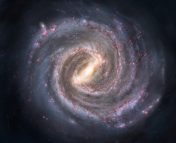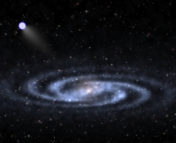Authors: Simon C. Schuler, Jeff J. Andrews, Vincent R. Clanzy II, Mohammed Mourabit, Julio Chanamé, and Marcel A. Agüeros
First Author’s Institution: University of Tampa
Status: Accepted to the Astronomical Journal
The formation, evolution, and structure of our Milky Way is a big question in the field of astronomy. You might be thinking “but don’t we live in the Milky Way? Haven’t astronomers been studying it for ages? If astronomers can map the cosmic microwave background, surely we must know pretty much everything there is to know about our Galaxy?” Funny enough, living inside the Milky Way makes understanding it even harder. In fact, some might consider it easier to study neighboring galaxies within our Local Group, like M 31 and M 33, than our own Galaxy. Living inside the Milky Way means that, unless we are looking within our immediate Solar Neighborhood, we have to peer through billions of stars along with tons of gas and dust in between us and whatever region we are trying to study. For example, astronomers disagree on how many spiral arms our Milky Way has, and it wasn’t until the 1990s that we determined the Milky Way is a barred spiral galaxy!
Galactic archaeologists seek to address these major questions regarding the structure and evolution of our Milky Way, and their title of “archaeologist” refers to their method of addressing these questions. Galactic archaeologists treat individual Milky Way stars as ‘fossils’, using their chemical and dynamical characteristics to trace our Galaxy’s history and present-day structure. So what is in a Galactic archaeologist’s toolbox? Today’s authors give us a great tour of this toolbox by using several effective tools to examine three stellar moving groups that have been previously assigned to belong to the Milky Way halo. The authors apply these tools to assess the origins of these moving groups and whether they are really part of the halo.
Moving Groups in our Galactic Halo?
Moving groups are groups of stars that appear to move together in space. They are interesting because, depending on their origin, they trace an interesting moment of the Milky Way’s star formation or accretion history. Moving groups have several origins: they could be groups of stars born together, either as-is or dispersed from a larger star cluster. They may also be groups of stars that are not necessarily born together but instead are trapped within Milky Way potential “resonances,” forced to move together due to interactions with potential forces from spiral arms in the Galaxy. Finally, moving groups may be the results of disrupted, accreted dwarf galaxies, and these moving groups tend to reside in our halo.
The Gaia astrometry space mission has transformed our understanding of the Milky Way’s stellar populations by reporting the positions, proper motions, and parallaxes of 2.8 billion stars within and outside our Galaxy. Moving groups were being discovered well before Gaia was launched, but Gaia has enabled us to discover thousands of new moving groups that enrich our view of the various stellar populations that make up our Galaxy. Today’s authors reexamine three moving groups discovered in 2012 pre-Gaia that were assigned as halo moving groups. The authors apply a plethora of tools from their Galactic archaeology toolbox to see whether these moving groups appear to be born together, whether they are really halo members, and from where they could have originated.
Tool One: Stellar Kinematics
The authors refresh the stellar kinematics from the original discovery period with Gaia and then analyze the kinematics of each group to a) confirm their halo-like velocity characteristics, and b) confirm that the kinematics of stars in each group appear to be similar, as would be expected with bonafide moving groups. In Figure 1, the authors present a Toomre diagram displaying their results. Toomre diagrams are plots that compare stars’ velocities in the direction of Galactic rotation (V) with those tangential to Galactic rotation (U, positive towards Galactic center, and W, positive towards North Galactic pole). It is clear that many of the stars in these moving groups do appear to have halo kinematics, as indicated by their placement on the Toomre diagram, overlapping the green region that represents standard halo kinematics. However, the authors note that the stars they sample from these moving groups are not as clustered in 3D velocity space as expected. After all, if they are moving groups, they are expected to be moving together. The black dots in Figure 1 display the velocity information for a bonafide halo moving group, GL-4, for comparison. Despite the relative lack of clustering in the Toomre diagram, however, of the three groups investigated, GL21-22 (red dots), appears to be the most promising, as it is decently clustered in Figure 1 and other analyses of stellar kinematics.
Tool Two: Stellar Dynamics
Next, the authors turn to stellar dynamics to see if this next tool might show more promising results that stars within these moving groups do indeed share an origin. To do this, the authors backwards-integrate the orbits of stars through the Milky Way potential to see if the stars appear to originate from a common region. Orbit integration is a powerful tool in the Galactic archaeology toolbox because it allows one to travel back in time with stars and see how they behaved in the past. Though the stars of these three moving groups don’t show the most promising present-day kinematics, it is possible that they once did and were since disrupted. Thus, orbit integration could contradict the kinematic analysis results and show that these groups indeed originate from the same region. If these stars were born together and/or originate from the same system, they should follow similar orbits as they travel the Milky Way. However, the authors find that the stars in these moving groups do not appear to share orbital properties. Again, things are not looking great for these moving groups. Though the authors caution that large uncertainties on Gaia astrometry could cause some of the disagreement in their orbital tracks, they note that it is likely that these moving groups are instead unrelated groups of stars that happen to share similar positions on the sky. To further explore this, they pull out their third and final tool, chemical abundance analysis.
Tool Three: Stellar Chemical Abundances
Stellar chemical abundances might be the most powerful tool presented today in the toolbox: they add a rich new dimension of understanding in the study of stellar groups. The chemical composition of a star acts like stellar DNA–it remains largely constant throughout most of the star’s life and traces the chemical composition of the molecular cloud from which it was born. Because of this, astronomers can investigate whether stars were born together in the same molecular cloud by studying how similar the stars appear chemically. Furthermore, the specific chemical composition of stellar groups can inform from where the group originated. For example, the Milky Way thick disk, thin disk, and various substructures in the halo each show unique chemical profiles. We can thus infer that if we observe a star to have a similar chemical profile to one of these Milky Way subpopulations, it may be a member.
The authors of today’s paper determine elemental abundances for 6 stars from GL21-22, the most promising moving group, and compare them to those of a) other stars within the same group, and b) various Galactic halo subpopulations. In Figure 2, the authors present their chemical abundance results for a few elements relative to iron. The colorful contours present different abundance patterns of stellar populations within the Galactic halo, such as the accreted halo population (LMg, blue) and the halo population that was born with the rest of the Milky Way in situ (HMg, green). We can clearly see that the stellar members of GL21-22 (red stars) span a wide range of chemistry. We see that some of its members have low metallicity while others high. Some appear to share chemical patterns with the in situ halo population, and others with the acretted population. This tells us that these stars are not really that chemically cohesive, and they likely were not born from the same molecular cloud (or if they were, then that cloud was not well-mixed).
So what’s left to explain the origin of GL21-22, if it doesn’t strongly look like the classic in situ halo population or the classic acretted population? The Gaia-Enceladus Sausage (GES) could be the answer. The GES is a subpopulation of stars in the halo that could be responsible for up to 50% of the halo stars we observe. It is understood to be a disrupted dwarf galaxy that was eaten up by our Milky Way approximately 10 Gyrs ago. In fact, the accretion of the GES could have driven the formation of our Milky Way thick disk. Stars within GL21-22 reasonably satisfy various criteria for GES membership. They show high eccentricities in their orbits, they overlap with the GES in various kinematic comparisons, and they also have metallicities within 1 sigma of the mean metallicity of GES member stars. If this is indeed the case, then the chemical abundances of stars in GL21-22 could shed new light onto the chemical composition of the GES.
Chemodynamics Shed Important Light on Stellar Populations
As we have seen in today’s paper, though moving groups may appear to share kinematics, chemical and dynamical analyses open up a rich new dimension for understanding these populations and assessing their origins. As exemplified by today’s paper, moving groups may appear to be kinematically related in some analyses, but deeper dives using updated astrometric data, orbit integration, and chemical analysis may reveal them to be otherwise unrelated. The Galactic archaeology toolbox is well-equipped for deep analyses into stellar groups and associations. Feel free to stop by and grab a tool any time for your own research project!
Astrobite edited by: Katya Gozman
Featured image credit: Cartoon by Catherine Manea, background image Denis Degioan/UNSPLASH




